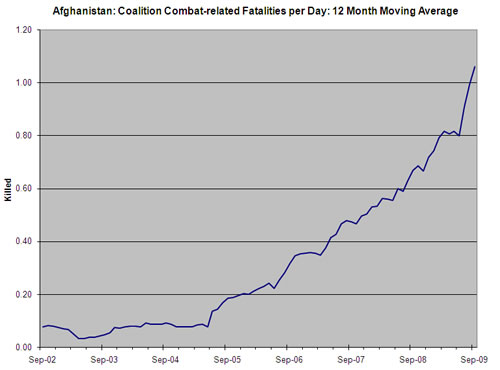"Afghanistats" and "strategery"
1) Afghanistats, 2009 version
2) Associated strategery musingsWe've run the stats on combat KIAs in Afghanistan here several times before. These are the updated versions.
This graph shows the daily rate of coalition combat-related fatalities, on a 12-month moving average basis to exclude seasonal effects. The actual seasonal effect has been increasingly minor, as the recent McChrystal review concluded correctly, "there is no fighting season." What this appears to indicate is an insurgency really appearing in the summer of 2005, and increasing steadily in strength since then. Most recently, in the last 3 months there has been a rapid increase in coalition casualties to an entirely new level. This is largely due to increased-tempo U.S. and British operations in Helmand province, which have taken high casualties. But consistently, every summer has been worse than the last summer, every winter has been worse than the last winter, and we are now approaching 400 coalition combat KIAs per year, and still increasing.What may be more revealing is when you break those stats out by province and year.
The following charts [emphasis added] show combat KIAs per province, starting in 2006. It indicates where the truly heavy fighting is, and where insurgents are making inroads...
UPDATE: Some inferences one might wish to see as supported by the provincial diagrams above, in no particular order:
**Many provinces, particularly in the Hazara-dominated center and the Uzbek-Tajik-dominated north, remain immune to significant Taliban influence. This is no surprise, given they are overwhelmingly a Pashtun insurgency. The exception is Kunduz.
**Uruzgan province, which has been managed by the Dutch and to a lesser extent the Australians, seems to have consistently resisted any increase in Taliban effectiveness, for whatever reason.
**The border areas around Jalalabad, east of Kabul, are seeing marginally less fighting on the whole than in the past. However, there does seem to be a concerted attempt to increase pressure on the environs of Kabul...
Read on, "security sponges".Okay, I'm tired of talking about T.E. Lawrence, but he does constitute a common frame of reference of sorts, so I'm going to do it one more time.
Lawrence, you'll recall, had three great insights worth remembering in the Afghan context. He advised both British and Arabs that the large Turk garrison in Medina, which was exerting no effect on anything, could be safely ignored; that the long rail line to Medina could be savagely interdicted, and that the port of Aqaba, if taken, could secure Arab logistics and their participation in the war. Hence, his early strategy of bypassing Medina, attriting the Turks along the railline, and seizing Aqaba.
In the Afghan context, one might ask, where is the insurgents' Medina? Where is their Aqaba? The rail line equivalent, one would argue, is fairly obvious: the long ring road Western and Afghan forces keep free of IEDs and ambushes at great cost every day. But where are they trying to tie us down, and where are they aiming to strike to expand their campaign to a new level of effectiveness?
The maps in the post below, showing the provincial breakdown of coalition fatalities, lend themselves to one interpretation.
That interpretation would be the increasingly compelling theory that the Taliban have little interest in controlling or even fighting in the country's major population centres any time soon, as that would highlight their deficiencies in governance and compromise urban sanctuaries where they can currently organize covertly so long as they remain unarmed and unthreatening (the best place to hide from UAVs being a city).
What they want to dominate militarily are the environs to those urban areas, the area within the sound of artillery fire (15-25km) in any populated direction from the city: close enough so the population feels threatened. In these environs areas, through rapid, destructive attacks on security infrastructure, targetted assassinations both in and outside the city, and intimidation-type information ops at night (and the occasional spectacular attack, like the one on Sarpoza prison), they keep the city population cowed and lacking confidence in their own government and the coalition without ever having to physically enter it or intentionally target the populace. This has already succeeded to a great degree in the Kandahar City environs [emphasis added, see start of this post and Update] ...












0 Comments:
Post a Comment
<< Home